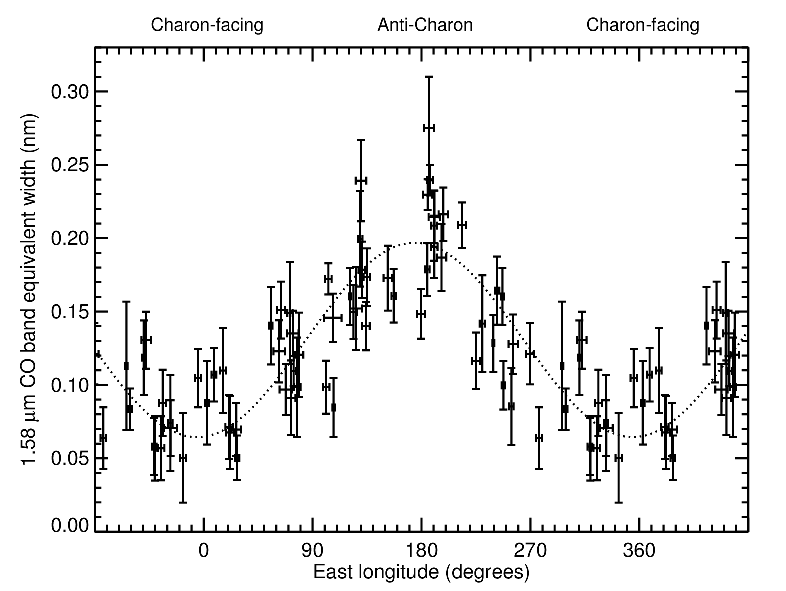
Near-Infrared Spectral Monitoring of Pluto's Ices: Spatial Distribution and Secular Evolution
Published in 2013: Icarus 223, 710-721.
W.M. Grundy1,2, C.B. Olkin2,3, L.A. Young2,3, M.W. Buie2,3, and E.F. Young2,3
(1) Lowell Observatory, 1400 W. Mars Hill Rd., Flagstaff AZ 86001.
(2) Visiting/remote observer at the Infrared Telescope Facility, operated by the University of Hawaii under Cooperative Agreement NNX-08AE38A with the National Aeronautics and Space Administration, Science Mission Directorate, Planetary Astronomy Program.
(3) Southwest Research Institute, 1050 Walnut St. #300, Boulder CO 80302.
Abstract
We report results from monitoring Pluto's 0.8 to 2.4 μm reflectance spectrum with IRTF/SpeX on 65 nights over the dozen years from 2001 to 2012. The spectra show vibrational absorption features of simple molecules CH4, CO, and N2 condensed as ices on Pluto's surface. These absorptions are modulated by the planet's 6.39 day rotation period, enabling us to constrain the longitudinal distributions of the three ices. Absorptions of CO and N2 are concentrated on Pluto's anti-Charon hemisphere, unlike absorptions of less volatile CH4 ice that are offset by roughly 90° from the longitude of maximum CO and N2 absorption. In addition to the diurnal variations, the spectra show longer term trends. On decadal timescales, Pluto's stronger CH4 absorption bands have been getting deeper, while the amplitude of their diurnal variation is diminishing, consistent with additional CH4 absorption at high northern latitudes rotating into view as the sub-Earth latitude moves north (as defined by the system's angular momentum vector). Unlike the CH4 absorptions, Pluto's CO and N2 absorptions appear to be declining over time, suggesting more equatorial or southerly distributions of those species. Comparisons of geometrically-matched pairs of observations favor geometric explanations for the observed secular changes in CO and N2 absorption, although seasonal volatile transport could be at least partly responsible. The case for a volatile transport contribution to the secular evolution looks strongest for CH4 ice, despite it being the least volatile of the three ices.

Fig. 3. Equivalent width of the 1.58 Ám 3-0 CO ice absorption band, showing a roughly three-fold variation as Pluto rotates, with maximum absorption being centered on the anti-Charon hemisphere. Each point represents data from one night's observations, with the horizontal error bar indicating the duration of the observations and the vertical error bar indicating the 1-σ uncertainty in the equivalent width of the 1.58 μm CO ice band. Points are duplicated outside the 0° to 360° longitude range to better show the cyclical pattern. The dotted curve is a sinusoid fitted to the data, with a constant offset, amplitude, and phase of maximum absorption as free parameters. The fitted values are 0.13 nm, 0.066 nm, and 174°, respectively.